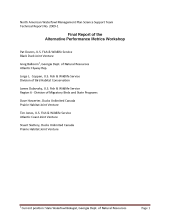
ABSTRACT
The NAWMP Science Support Team’s (NSST) Alternative Performance Metrics Subcommittee hosted a 2-day workshop on 5-6 August 2008 at Patuxent National Wildlife Research Center - Laurel, MD to explore alternative metrics for measuring progress in achieving NAWMP goals by linking habitat actions to vital rates regionally. This workshop resulted from a recommendation introduced in the NSST’s Technical Report No. 2008‐1 entitled “Continental Progress Assessment Report Recommendation A.1 – NSST Scoping Document: A Report to the Plan Committee from the NSST.” The workshop goal was to measure our collective influence on waterfowl across spatial scales. The objectives of the workshop were to: I. Understand the biological and administrative need for new alternative metrics that apply across Joint Ventures; II. Identify candidate metrics; III. Develop an objective process to evaluate and select preferred metrics; and IV. Achieve consensus around a limited number (1–3) of preferred alternative metrics for implementation under the NAWMP.
A small group of invited Joint Venture Science Coordinators and representatives from the Flyway Councils and Federal Agencies were selected to participate and provide broad representation, skills, and backgrounds from the waterfowl community. Results and recommendations from the workshop are submitted in this report.
Workshop participants reached consensus on a general monitoring framework. In the short-term, workshop participants agreed to the following:
i. JVs should frame their accomplishments in terms of changes in demographic parameters (i.e., season specific vital rates).
ii. All JVs should adopt the annual life cycle model (Fig. 1) as the basis of their monitoring program. This framework explicitly links ecologically similar JVs (i.e., breeding JVs or wintering JVs), thus facilitating decisions about appropriate levels of resource redundancy required to meet the life cycle needs of waterfowl among JV’s, and links JVs temporally throughout the year.
iii. Individual JVs should develop conceptual or empirical models to explicitly describe how habitat management actions influence vital rate(s) and JVs should develop monitoring programs to track the direct influence of their management actions on the quality and quantity of refuge areas and food resources. Resulting estimates then provide information on local impacts of JV actions and can be rolled up across JVs to estimate cumulative impacts on waterfowl population dynamics and carrying capacity at the continental scale.
iv. At the JV scale this framework should be used to complement traditional metrics including number of acres protected, enhanced, or restored, dollars spent, and dollars leveraged.
v. At the continental scale, this framework will complement the current metric of comparing continental population size to the population goal.
vi. In the long-term, JVs should incorporate the influence of both their management actions and population size (Fig. 3) on vital rates. This next step will allow managers and researchers to understand the impact of density-dependence on management actions and vital rates.
